The main category of Fitness News.
You can use the search box below to find what you need.
[wd_asp id=1]
The main category of Fitness News.
You can use the search box below to find what you need.
[wd_asp id=1]
As told to Nicole Audrey Spector
October 10, 2025, is World Mental Health Day.
I was the third of four children, each four years apart, and the only female. That last part wasn’t a good thing in my family. Girls, I was taught, were dumb. In my home, there was a hateful mantra directed at me: “Don’t be a dumb girl.” My family would shorten it to an acronym, “DBADG.” Anytime I did something that made me look feminine or weak, I’d hear those letters.
My dad was an intensely angry man and was both physically and emotionally abusive to me. In fifth grade, I failed my Social Studies class. When he found out, he burst into my room and slapped and pushed me around for what felt like hours. When he was finally finished, he had me go collect all my “F” papers and tape them up on my bedroom wall. “Now all your friends will see how stupid you are,” he said. I was 11.
After that night, I knew I couldn’t trust myself to be smart. I believed that failure was inevitable, no matter how hard I tried. I started cheating on tests and forging my parents’ signatures on exams I’d failed.
Life was a matter of surviving moment to moment, of navigating not only the physical abuse from my father but also sexual abuse at the hands of one of my older brothers. Additionally, my mom was an alcoholic and not able to really be there for me.
Athleticism was a language my family understood and valued, so my being out of the house at practice or a game wasn’t an issue. And I loved sports. They were a safe space for me. On the court, hitting was against the rules. There were consequences. And a responsible adult was always paying attention. I had none of that at home.
It wasn’t until I was in college, studying psychology and embarking on my own mental health journey in therapy that I began to understand that the home I’d grown up in was deeply dysfunctional. I met my now-husband and built a truly safe and healthy relationship. I was so afraid I’d lose him, that he’d get sick of me and leave.
After my husband and I were married for five years, we had our first of two children. We waited partly because I was struggling so much with nightmares and insecurities surrounding parenthood. I was determined to give my children everything I didn’t have — unconditional love, security, confidence and support.
On April 20, 1999, my life took a new direction. My kids were 1 and 4 when the Columbine High School massacre, the mass shooting that killed 12 students and a teacher, happened. It sparked major debates over gun control laws in the U.S. It all struck a chord with me and I felt profoundly called to action in a way I never had been before. For me, Columbine High wasn’t just some random school in some random city. Columbine High was my high school. It was the place that had sheltered me from the violence of my home life as a kid.
Dave Sanders, the wonderful teacher who was killed, had been my basketball coach. That library, where so many children had been shot, had been my sanctuary. When I attended Sanders’ funeral, I remember looking at all my former teachers and taking in their sobs and red, swollen stares.
After Columbine, I felt an enormous sense of responsibility to take whatever action I could to help prevent gun violence from happening and dove into the world of gun control advocacy, which was more than a little bit intimidating. Growing up with a dad who was a ticking time bomb made me terrified of confrontation — and people who feel passionately that you are threatening their rights, even if that’s not at all what you’re doing, will be confrontational. As I became an emerging voice in the gun control advocacy community, I was increasingly up against gun enthusiasts who could be aggressive toward me. I’d thought I was free from the trauma of my childhood, but I was still emotionally and mentally shackled by it, still hearing my father’s enraged voice. Still living in fear.
If I wanted to actually make a difference in the world, I needed to shatter the toxic beliefs tied up in the “DBADG” philosophy I was raised on. It wasn’t easy. Sometimes I’d freeze during speeches when people in the audience screamed at me for being a “gun grabber.” But over time and with the support of my husband, I gained my footing and let go of anxieties that my voice wasn’t worth being heard.
All these years later, I’m an accomplished author with articles and books published not only about gun violence but also about enduring physical and sexual abuse at the hands of family members. This year, my memoir called Dumb Girl: A Journey from Childhood Abuse to Gun Control Advocacy was published.
Healing isn’t an overnight experience. I’ve gone through decades of intensive therapy. Though I’ve come a long way in coping with my childhood trauma, there’s still a part of me that insists on calling myself dumb. When I feel that urge, I challenge myself and ask, “Would you talk to your daughter that way?” Of course I never would.
So that’s my challenge: to silence those inner thoughts, knowing that each time I do, I step further from the girl who felt dumb and closer to the smart woman I know that I am.
Have your own Real Women, Real Stories you want to share? Let us know.
Our Real Women, Real Stories are the authentic experiences of real-life women. The views, opinions and experiences shared in these stories are not endorsed by HealthyWomen and do not necessarily reflect the official policy or position of HealthyWomen.
From Your Site Articles
Related Articles Around the Web
El término “biosimilares” suena como algo de una novela de ciencia ficción, pero afortunadamente son avances reales de la medicina. Pero, para entenderlos mejor, primero debemos comprender un tipo de medicamentos denominados biofármacos. Retrocedamos un poco.
La mayoría de medicamentos que las personas toman son fármacos de moléculas pequeñas, lo que significa que tienen una estructura química simple y su preparación es relativamente fácil. Incluyen muchos medicamentos comunes tales como aspirinas y antibióticos.
Los biofármacos son un tipo diferente y más nuevo de medicamentos que están compuestos por macromoléculas grandes y orgánicas, usualmente proteínas. Son mucho más complejos que los fármacos de moléculas pequeñas. Ejemplos de biofármacos son inmunoterapias para tratar el cáncer, terapias con células madre para una variedad de trastornos complejos y vacunas para prevenir enfermedades infecciosas.
Los biofármacos son medicamentos preparados a base de células vivas, piensa en proteínas tales como anticuerpos, hormonas, enzimas”, explicó Annie DePasquale, M.D., doctora de medicina familiar certificada y fundadora de Collaborating Docs. “Los medicamentos tradicionales (tales como la mayoría de comprimidos) son moléculas pequeñas sintetizadas químicamente para las cuales cada lote es idéntico. Los biofármacos se cultivan en sistemas vivos, así que son por naturaleza más variables y requieren controles de calidad extremadamente altos.
Piensa en eso de esta forma: Cada químico es como un componente. Si juntas varios componentes de cierta forma, obtendrás un fármaco de moléculas pequeñas. Cualquier persona que tenga los mismos componentes y los junte de la misma forma podrá preparar una copia exacta del original. Cuando esto se hace en el ámbito de fármacos de moléculas pequeñas, obtenemos medicamentos genéricos. Son copias exactas del original, iguales a medicamentos de marca, pero sin la marca, lo cual hace que resulten menos caros.
Los biofármacos son mucho más complicados. En vez de una estructura simple y compuesta por unas docenas de componentes químicos, estas macromoléculas tienen miles de piezas en una configuración muy compleja. La preparación de un biofármaco requiere mucho más que agregar cada elemento correctamente. Son compuestos orgánicos y deben prepararse en células vivas, usando tecnología de ADN.
Cuando preparas una copia de un biofármaco para incrementar el acceso a esta terapia, obtienes un biosimilar, una terapia que es igual de segura y efectiva que el tratamiento original. Sin embargo, hay diferencias estructurales. Imagina que es algo parecido a hornear pan. Puedes usar los mismos ingredientes y seguir la misma receta, pero cada pedazo de pan es un poco diferente. Las copias biosimilares de biofármacos no son precisamente idénticas a los originales, pero son muy similares. Lo importante es que tienen la misma seguridad y eficacia.
De biofármacos a biosimilares
Los genéricos nos dan acceso al mismo tratamiento a menor costo. Los biosimilares, al igual que los genéricos, hacen que ciertos tratamientos avanzados sean más asequibles y accesibles.
Los biofármacos son muy caros. Puede tomar más de 10 años y costar miles de millones de dólares en desarrollo de un solo biofármaco. Ese costo se transfiere a los pacientes y aseguradoras. “Incluso cuando varios competidores empiezan a producirlos, los biofármacos siguen siendo más costosos que la mayoría de píldoras, y es ahí donde los biosimilares son útiles para reducir costos”, dijo DePasquale.
Pero los biosimilares no son exactamente baratos: Su desarrollo también toma años y cuesta millones de dólares. Pero el costo total de desarrollo es mucho menor que el de un biofármaco original. Consecuentemente, su uso puede aprobarse más rápido y con menos gastos. Esta reducción de costo puede ser útil para solucionar algunas disparidades. Personas de grupos históricamente marginados, especialmente si tienen seguros públicos, son menos propensas a comprar los biofármacos indicados en sus recetas médicas. Con biosimilares más asequibles, más personas pueden beneficiarse de medicamentos avanzados.
Cómo se preparan los biosimilares
iStock.com/Alernon77
Al igual que los biofármacos, los biosimilares se preparan mediante un proceso complejo usando tecnología de ADN.
Primero, el código genético para una proteína específica se inserta en células vivas. Estas células podrían ser levadura o bacterias, así como células vegetales o animales. Las células “leen” el código como si fuese una receta y empiezan a producir cantidades importantes de proteínas Son como miles de millones de cocinas diminutas y orgánicas. Y tienen estándares altos. El entorno debe ser altamente controlado para que las condiciones sean adecuadas. Una vez que las células producen la proteína, se aísla y purifica para su uso como un medicamento biosimilar. Estos medicamentos pueden administrarse entonces a pacientes mediante inyecciones o infusiones IV.
Beneficios bioequivalentes
Entonces, ¿son los biosimilares tan seguros y efectivos como los biofármacos originales? La respuesta es sí. “La FDA [Administración de alimentos y medicamentos] evalúa rigurosamente los biosimilares usando un método en función de ‘toda la evidencia’”, dijo DePasquale. “Eso incluye pruebas analíticas para demostrar una alta similitud, estudios del comportamiento del medicamento en el cuerpo, evaluaciones de inmunogenia (el riesgo de que el cuerpo reaccione a la proteína) y al menos un estudio clínico para confirmar que no haya diferencias significativas”.
Un biosimilar debe tener características muy similares a las del biofármaco original (denominado producto de referencia) para que se considere bioequivalente:
En otras palabras: Los biosimilares no tienen ninguna diferencia clínicamente significativa en comparación con los productos originales de referencia. Funcionan de la misma forma. Proporcionan los mismos beneficios. “En comparaciones entre los dos productos, los biosimilares tienen un desempeño equivalente al de los productos de referencia para los trastornos para los que se aprobaron los tratamientos”, dijo DePasquale. “Muchos pacientes han hecho el cambio de un biofármaco de referencia a un biosimilar sin ninguna pérdida de eficacia y sin problemas de seguridad nuevos”.
¿Qué tratan los biosimilares?
Los biofármacos y los biosimilares pueden tratar “una amplia gama de trastornos que [tienen un gran impacto en] las mujeres o que frecuentemente surgen durante la mediana edad”, explicó DePasquale:
Los biosimilares son medicamentos avanzados y pueden imitar procesos biológicos naturales del cuerpo. Se dirigen y adhieren a células específicas, interactúan con proteínas y bloquean o activan reacciones inmunitarias. Consecuentemente, son muy útiles para evitar que ciertas células hagan cosas que empeoren o propaguen trastornos. Con el menor costo y el mayor acceso de los biosimilares, más mujeres pueden recibir el mejor tratamiento posible para vivir las mejores versiones de sus vidas.
Este recurso educativo se preparó con el apoyo de Sandoz.
From Your Site Articles
Related Articles Around the Web
October is Breast Cancer Awareness Month.
Around 1 in 5 breast cancers are HER2-positive. HER2-positive cancers are a type of breast cancer that contains higher-than-normal levels of HER2 proteins, which help cancer cells grow and multiply. HER2-positive cancers can spread quickly, but they also have one of the highest survival rates when diagnosed early, thanks to highly effective treatments that specifically target HER2 proteins.
Understanding how HER2 status is diagnosed and treated can help you advocate for yourself and make informed decisions as a crucial member of your medical team.
We asked Roshani Patel, M.D., FACS, medical director of the breast program at Jersey Shore University Medical Center and member of HealthyWomen Women’s Health Advisory Council, what women should know about HER2-positive breast cancer.
What is HER2-positive breast cancer?
HER2-positive breast cancer cells have parts that I like to describe as “antennae,” which send messages to the cancer cells telling them to divide quickly. That makes this type of cancer aggressive, and that’s bad news. The good news is that your medical team can block the signal that’s sent from the antennae. The medicine we use to fight HER2-positive cancer is very effective because we have these parts that we can target — especially if we can treat the cancer early, before it spreads.
What are the risk factors?
Risk factors for HER2-positive breast cancer are the same as they are for all types of breast cancer. Family history plays a role: having a first-degree relative (a mother, sister or daughter) with breast cancer doubles your risk. Eating an unhealthy diet and obesity play a role. Metabolic syndrome also contributes to your breast cancer risk. Metabolic syndrome is a combination of at least three of five health issues: low HDL — or “good” — cholesterol, high triglycerides, high fasting blood sugar, high blood pressure and having fat around the stomach.
How is HER2-positive breast cancer diagnosed?
HER2-positive breast cancer is diagnosed through a biopsy. A radiologist or surgeon will take a sample of the tumor. The sample goes to a pathologist and special dyes are used to identify targets on the cells.
What are brain metastases and leptomeningeal spread in HER2-positive breast cancer?
When HER2-positive breast cancer spreads, it is one of the most likely breast cancers to spread to the brain and the leptomeninges. Think of the leptomeninges as a bed sheet that acts like a thin cover around your brain and spinal cord.
Why do HER2-positive breast cancers have a higher risk of brain metastases and leptomeningeal spread?
HER2-positive cancer cells can spread through the blood-brain barrier. The blood-brain barrier keeps your brain out of harm’s way from things like germs, viruses and bacteria, but some cells can get through. HER2-positive cancer cells can spread through the blood-brain barrier because they have substances that make them stickier. Also, some cells act like chameleons or shape-shifters and can change so they can pass through.
What treatments are used for HER2-positive breast cancer?
HER2-positive cancer is treated with surgery, chemotherapy and targeted antibody treatments. Monoclonal antibodies like trastuzumab target the HER2 proteins to stop them from multiplying and signal the immune system to fight the cancer. More antibody treatments have been developed and are rapidly evolving. These drugs can effectively enlist the body’s natural immune system to fight cancer. Treatments have gotten so effective that survival rates for stage 1 are over 90%. The rate for stage 2 survival is 85–90% and even at stage 3, survival is above 80%.
This educational resource was created with support from Merck and Daiichi.
From Your Site Articles
Related Articles Around the Web
The holidays are just around the corner, and you know what that means — it’s time to get your flu vaccine!
You probably thought we were going to say holiday parties and presents, but that’s the thing about the flu. It can germ its way into your festive spirit and ruin all your plans with fever, headache, chills, body aches and joint pain.
“The influenza virus is nasty,” said Ilan Shapiro, M.D., senior vice president and chief health correspondent and medical affairs officer for AltaMed Health. “And what do I mean by nasty? Compared to other viruses that cause a little runny nose and cough, it’s one full week off of work or school or anything that we enjoy doing — it’s not a regular virus.”
The flu can even be life-threatening. Last year, 28,000 people in the U.S. died from flu-related illnesses and the rate of flu-associated hospitalizations was the highest it’s been since 2010.
Read: Is it Covid, RSV or the Flu? >>
Shapiro noted that last year’s virus stuck around for a long time, so getting the vaccine as early as you can (ideally in October) will help protect yourself from serious illness throughout the flu season.
“If we want to have a beautiful Thanksgiving, if we want to enjoy our Christmas dinner and we want to sing along with family on New Year’s, there are opportunities here to make sure that our immune system is ready for that,” Shapiro said.
The vaccine takes about two weeks for your immune system to build up antibodies to protect against the virus.
Most people associate the flu vaccine with a shot in the arm, but there is a nasal spray option for people 2 to 49 years old. Note: The nasal spray is not recommended for people with certain chronic diseases or people who are pregnant. Of course, talk to your healthcare provider (HCP) if you’re interested in the nasal spray flu vaccine.
In addition to your health, here are Shapiro’s top reasons for getting the flu vaccine this year:
Flu vaccine = better health
We know life is busy and there never seems to be enough hours in the day to get everything done. But taking time to get the flu vaccine can help you and your loved ones stay as healthy as possible.
It’s good to note that the vaccine is recommended for everyone ages 6 months and older (with a few rare exceptions). If you have concerns or are still on the fence about getting the flu vaccine, Shapiro said to talk to your HCP. “It’s OK to have questions. It’s OK to have even fear, but for women, especially as leaders of the family where people depend on you, it’s a great opportunity to make sure you have the correct information to make the best choice for you and your family.”
From Your Site Articles
Related Articles Around the Web
By Gia Calhoun
Many new mothers underestimate the role of breath work and exercises in postpartum recovery.
We at Women Fitness got in touch with Gia Calhoun, a Pilates teacher based in Los Angeles, to answer common concerns often raised by new mothers. Gia has been part of Pilates Anytime since 2013, where she also served as Vice President, and she continues to be featured as a teacher on the platform.
Breathing is one of the most powerful starting points after childbirth because it’s gentle, accessible, and deeply restorative. Even before you’re cleared for exercise, you can safely begin with breathwork. Practicing diaphragmatic breathing helps regulate the nervous system, which is especially valuable during those early weeks when you may feel overtired, anxious, or overwhelmed. It also provides a way to co-regulate with your baby, helping them feel calmer and more secure.
On a physical level, breathwork initiates the process of reconnecting with your core and pelvic floor, two areas that are significantly affected during pregnancy and childbirth. Diaphragmatic breathing encourages the core muscles to re-engage gently and supports pelvic floor recovery without adding strain. In this way, breathing lays the foundation for safe, effective movement and a smoother postpartum recovery.
For moms with diastasis recti, diaphragmatic breathing is one of the safest and most effective ways to begin reconnecting with the core. Diastasis is the separation of the abdominal muscles, and deep, intentional breathing helps recruit the diaphragm and deeper core muscles, including the transverse abdominis, without adding pressure to the midline.
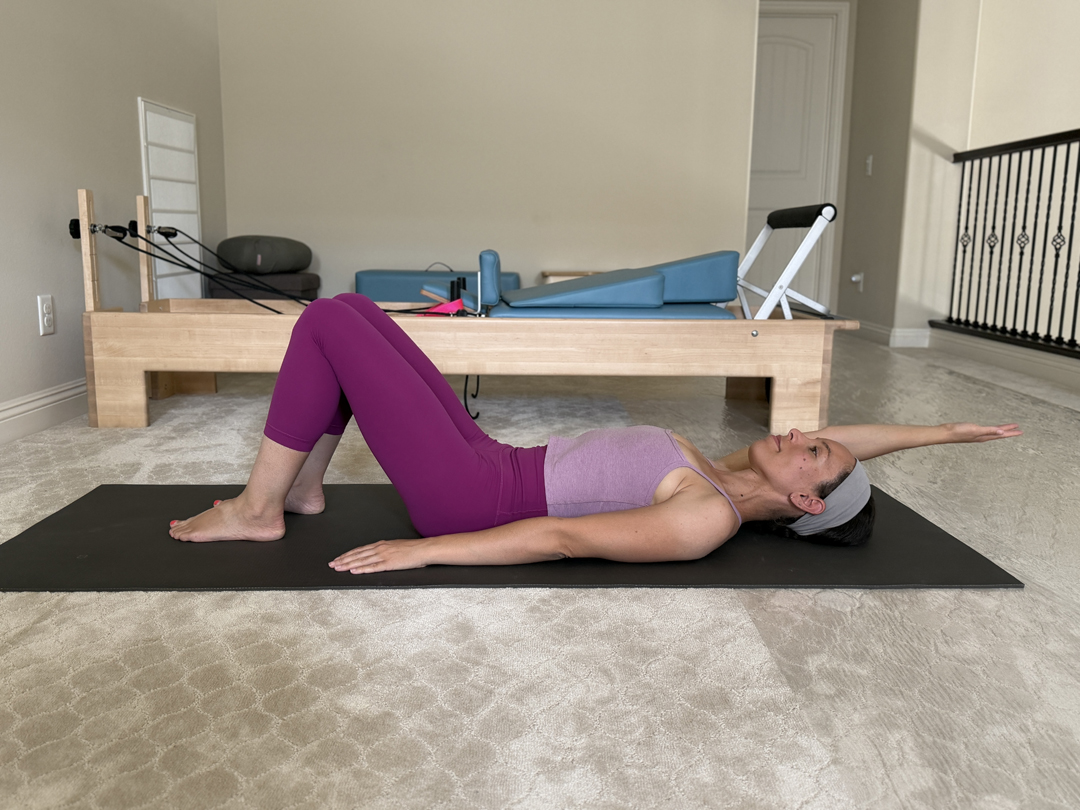
When practicing, the focus should be on full, expansive breaths that allow the ribcage and abdomen to gently expand on the inhale, followed by a controlled exhale that engages the deep core and pelvic floor. As strength and control improve, moms can gradually increase the length and control of the inhale and exhale to build more endurance. This mindful approach lays the groundwork for healing and prevents further strain on the abdominal wall.
One simple technique new mothers can practice anywhere, even while feeding or resting, is a gentle box breath. Here’s how it works: inhale through your nose for 4 counts, hold for 4 counts, exhale slowly through your mouth for 4 counts, and then hold again for 4 counts. As you feel more comfortable, you can gradually lengthen each phase to 5 or 6 counts.
This practice helps regulate the nervous system, reduce stress, and promote calm. At the same time, the controlled inhale and exhale encourage gentle activation of the core and pelvic floor, supporting your recovery in a safe, accessible way. It’s a simple yet powerful tool you can return to anytime you need a reset.
A safe and effective way to begin strengthening the pelvic floor and core is through quadruped breathing. To practice, come onto your hands and knees with your spine in a neutral position. As you inhale, allow your belly to relax and gently expand. On the exhale, draw your belly back toward your spine, engaging the deep core and pelvic floor. This position works beautifully because gravity provides gentle resistance, helping these muscles activate more deeply without added strain.
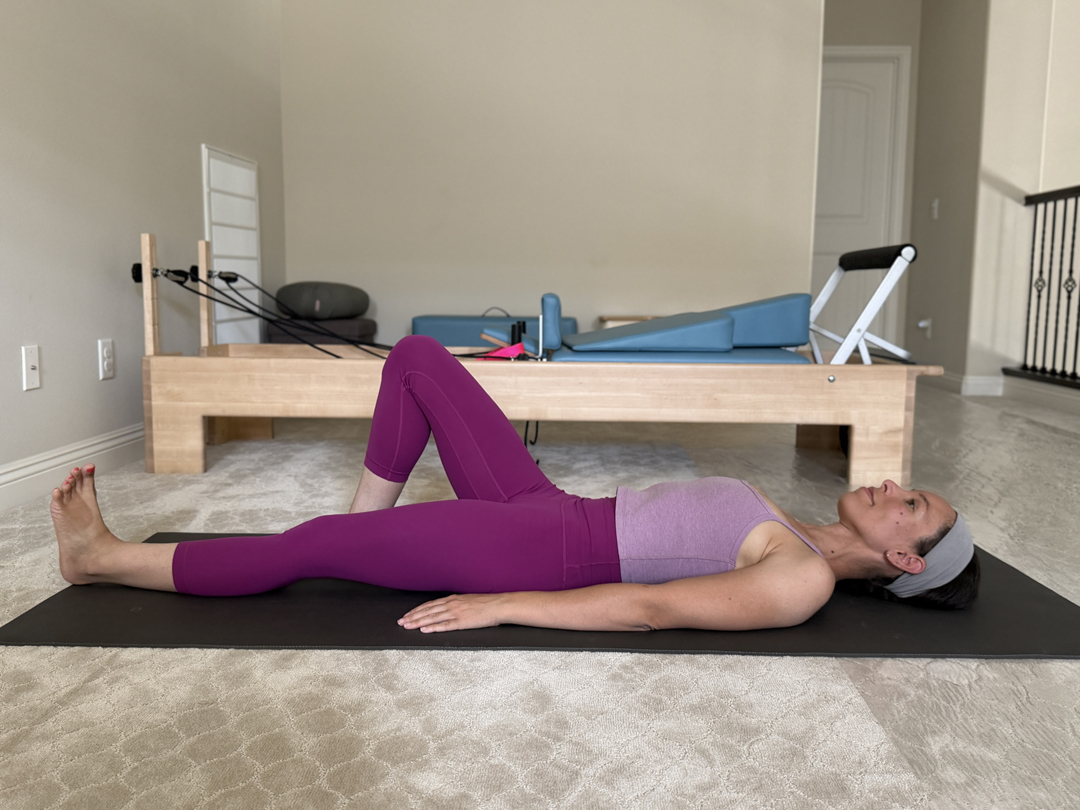
Another simple exercise is a heel slide. Lie on your back with your knees bent and feet flat on the floor. As you inhale, keep your core relaxed. On the exhale, engage your deep core and pelvic floor, and then slowly slide one heel away from your body, extending the leg along the floor. Inhale and bring the heel back in. Keep alternating sides. Move slowly and with control.
Both of these exercises are low-exertion yet effective ways to gently reactivate and strengthen the core and pelvic floor after childbirth, creating a solid foundation for more advanced movement.
After childbirth, the shoulders and upper back often need extra attention. Hours of feeding, rocking, and carrying a baby can create tightness and fatigue in these areas. A gentle mobility exercise is to lie on your back with your knees bent and feet on the floor. Inhale as you lift your arms toward the ceiling, then exhale as you slowly reach them overhead toward the floor. Inhale to return your arms to the ceiling, and exhale as you lower them back down by your sides. You can move both arms together or alternate one at a time. This simple movement opens the chest, mobilizes the shoulders, and eases upper back tension.
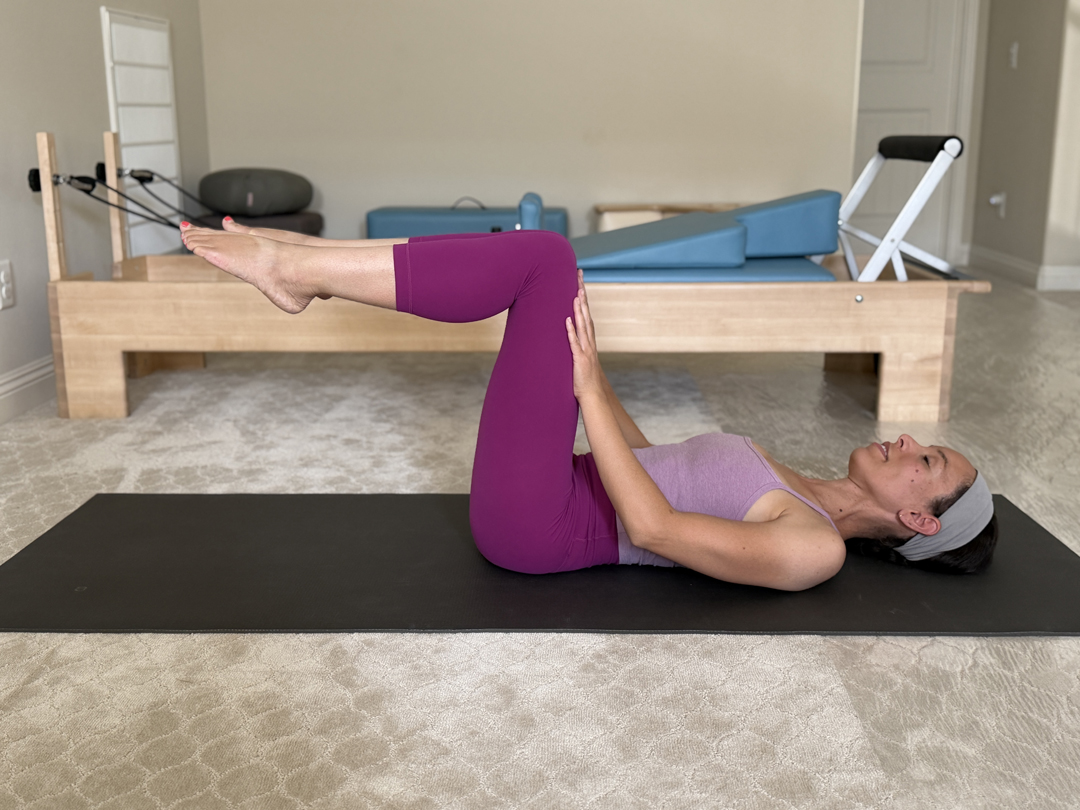
The hips also tend to become tight from more time spent sitting. A great way to release them is with a figure 4 stretch: lie on your back with both knees bent, then cross one ankle over the opposite thigh. From there, gently draw the lower leg in toward your chest until you feel a stretch through the outer hip. Hold for a few breaths before switching sides.
Both of these movements are gentle, restorative, and easy to integrate into daily life, helping new moms relieve tension and restore mobility.
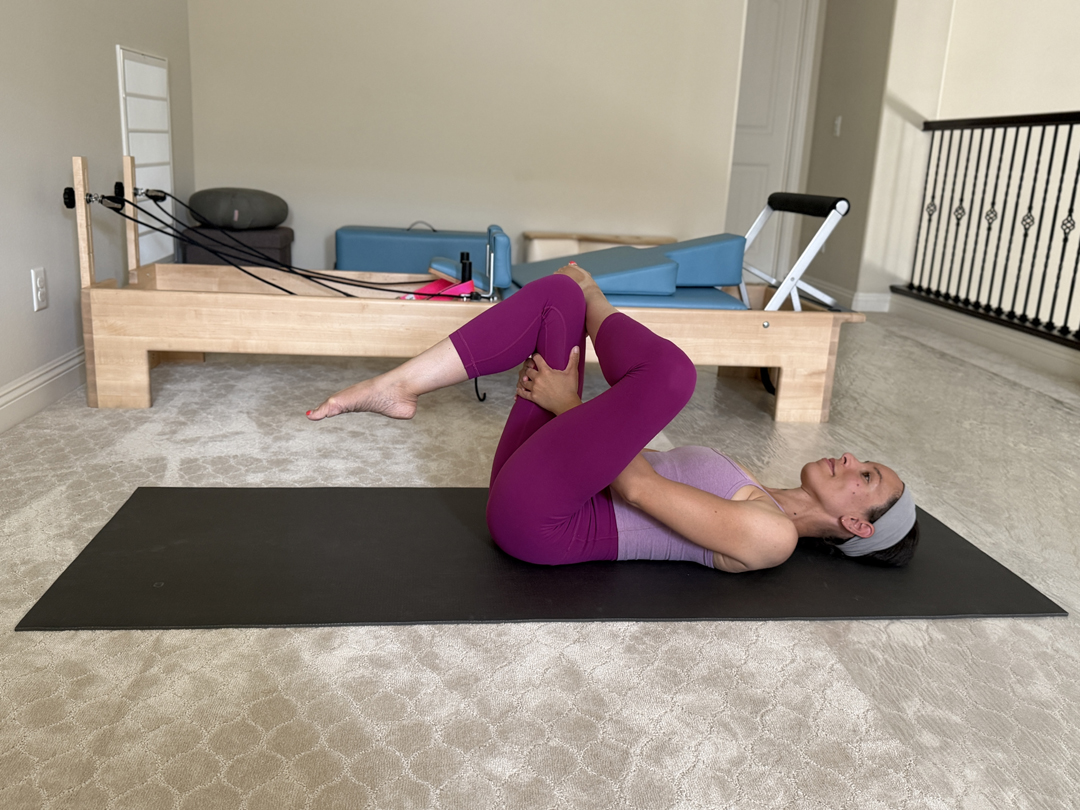
Here are five gentle postpartum exercises that can help improve posture and ease the strain from nursing or carrying your baby:
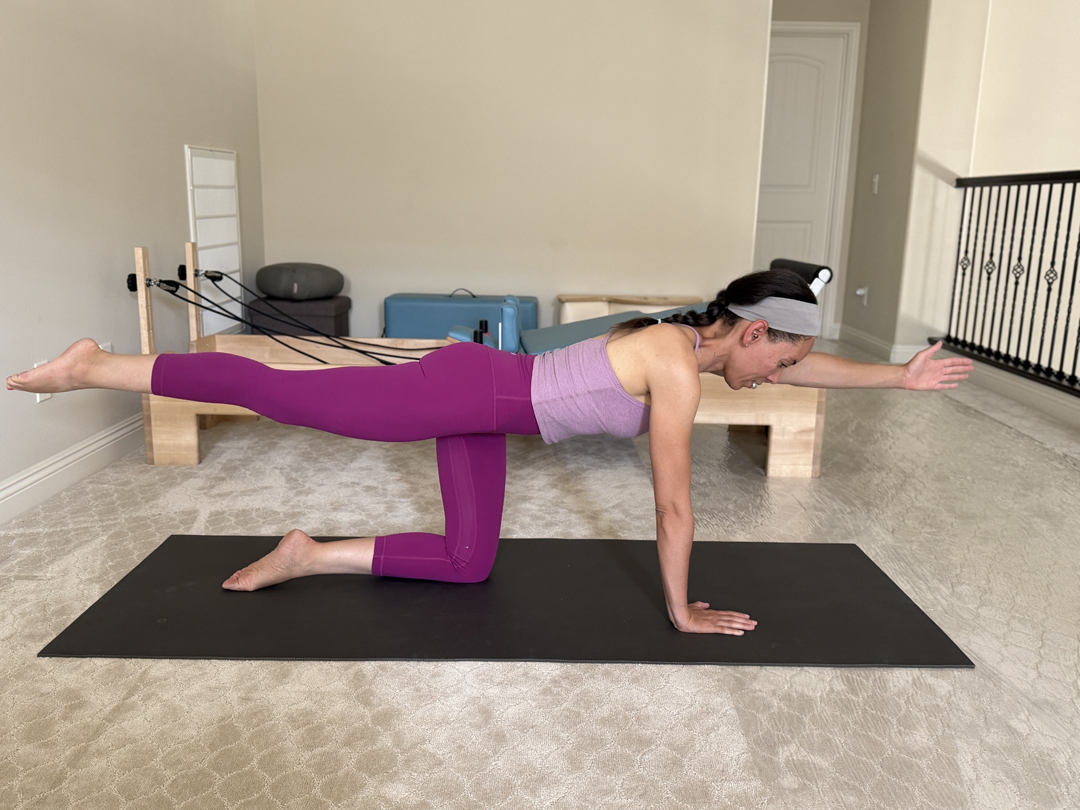
These movements are simple yet powerful ways to realign your body, strengthen the muscles that support posture, and create relief from daily repetitive tasks like nursing, rocking, and carrying your baby.
My biggest advice is to take things slowly and release the pressure to “bounce back.” Postpartum recovery is a journey, and every step forward counts. Even a few minutes of gentle movement can shift your energy, improve your mood, and help you feel more connected to your body.
It’s also important to let go of comparison, whether to others or to your “pre-baby” self. Instead, focus on what feels good and supportive right now. Celebrate the small wins, practice patience, and approach yourself with the same compassion you offer your baby. Consistency, not intensity, is what creates lasting strength and confidence.
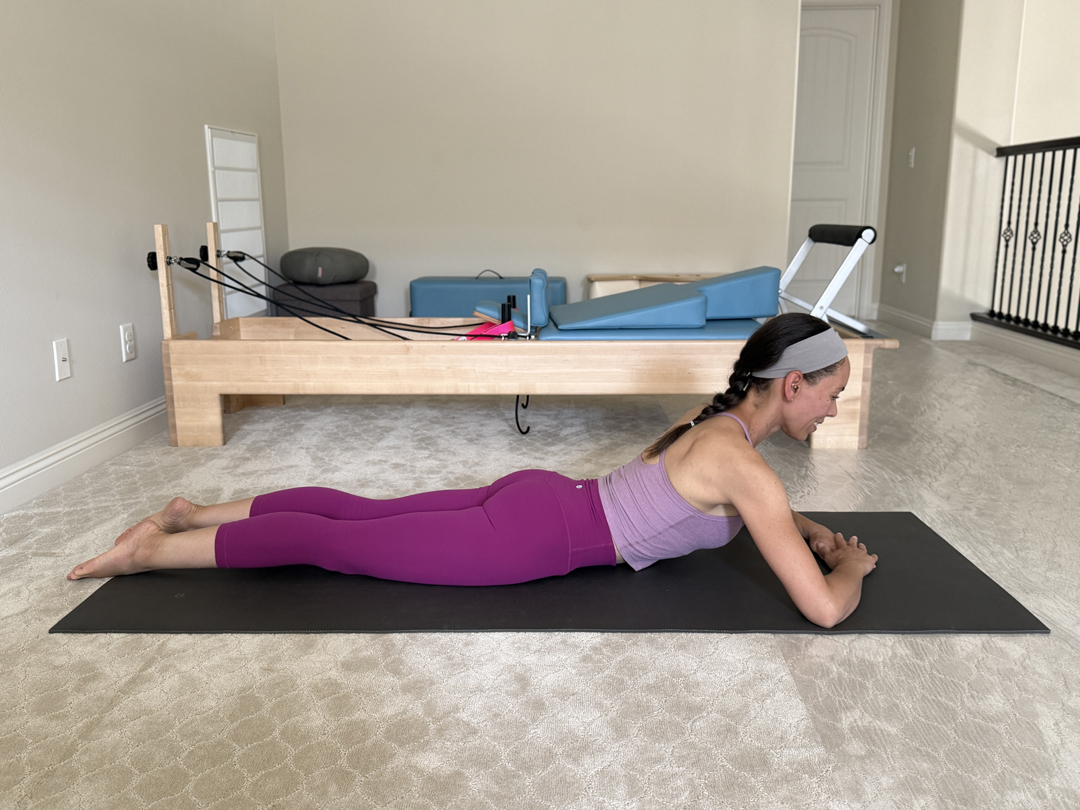
Gentle postpartum movement offers more than physical benefits; it can provide a much-needed sense of relief and grounding during a time that often feels overwhelming. Even short sessions can help reduce stress, lift your mood, and create space to reconnect with yourself.
Prioritizing your own well-being isn’t selfish. It allows you to show up with more energy, patience, and presence for your baby. Movement becomes a way to nurture both body and mind, reminding you that caring for yourself is an important part of caring for your family.
Self-care is essential, not optional, for both your physical and mental well-being. To show up fully for your baby, you first need to show up for yourself. Taking even small moments to breathe, move, or simply rest helps you stay grounded and connected to your own needs.
When you honor and care for yourself, you’re not only replenishing your energy, you’re also modeling balance and self-respect for your child. Remember, caring for yourself is an act of love that benefits both you and your family.
About the Author:
Gia Calhoun is a Pilates teacher based in Los Angeles, California, who has been teaching since 2007. She is the creator of Move with Gia, a Pilates app offering on-demand and live classes designed to make movement accessible anytime, anywhere.
Gia has been part of Pilates Anytime since 2013, where she also served as Vice President, and she continues to be featured as a teacher on the platform. She completed her comprehensive teacher training with Diane Diefenderfer at Studio du Corps in Costa Mesa, California. In addition to her online teaching, Gia has presented at Pilates Week at Rancho la Puerta in Tecate, Mexico.
Disclaimer
The Content is not intended to be a substitute for professional medical advice, diagnosis, or treatment. Always seek the advice of your physician or other qualified health provider with any questions you may have regarding a medical condition.
When it comes to innovations in healthcare, Maneesha Ghiya means business.
As a venture capitalist and investor at hedge funds, the Harvard Business grad has spent more than 25 years — pretty much her entire career — investing in healthcare.
But when a medical emergency almost took her life, Ghiya saw firsthand the need for innovation in women’s healthcare specifically. So, she started her own venture capital firm, FemTech Ventures, to fill that gap.
FemTech Ventures partners with businesses to advance women’s health through medications, devices, digital and artificial intelligence, and diagnostics (imaging, tests and tools).
The firm’s investment approach looks at women’s health conditions in three ways: “Only women” (endometriosis), “mostly women” (breast cancer) and “differently in women” (heart disease).
“We created and published this framework in 2019, and it has since been adopted by many others across the healthcare industry. By defining women’s health more broadly, we are able to identify and bring forward innovations that address conditions across women’s health,” Ghiya said.
We asked Ghiya for her thoughts on the technology-based solutions that are making waves in women’s health, and how her own health scare inspired her passion for change.
Our interview follows, edited for clarity and length.
HealthyWomen: Tell us about your experience with postpartum hemorrhage and how it led to the launch of FemTech Ventures?
Maneesha Ghiya: When I gave birth to my daughter at Columbia University under the care of a top OB-GYN, I encountered serious complications.
What began as an emergency C-section turned into a crisis with an undetected internal bleed. Four surgeons performed a reoperation that was ultimately unsuccessful in locating the source, and I was transferred to the ICU, where I underwent 10 transfusions of blood and platelets.
Fortunately, my body caught up with the bleed, and I survived. But that ordeal fueled a desire for me to make a difference in women’s health, which led me to found FemHealth Ventures.
Read: Postpartum Hemorrhage Is a Deadly Problem >>
HW: Historically, we know that women’s health has been overlooked and underfunded. How is femtech helping to broaden interest in women’s health?
Ghiya: We invest in drugs, devices, diagnostics, and digital and artificial intelligence in the women’s health space. We consider femtech a subset of women’s health and would see any software or AI platforms tailored towards women’s health falling into our digital and AI investment focus.
For example, we invested in a company called Cercle. Cercle AI’s product analyzes patient records within a fertility clinic, allowing doctors to quickly access data on how similar cases were treated, including protocols, success rates and side effects.
This helps optimize treatment plans, leading to higher success rates — which, for those familiar with the IVF journey, is incredibly impactful.
Read: Infertility Isn’t Just a Physical Journey — It’s an Emotional One, Too >>
HW: What are you finding most exciting in the world of femtech right now?
Ghiya: I’m excited to see how AI and robotics can raise the standard of care across medical centers.
One exciting application we see in the robotics and AI category is for needle-based procedures. For instance, consider epidurals during labor — 1 in 10 either fail or need adjustment because each person has a different anatomy, which makes it challenging even for experts to achieve precise needle placement.
One of our portfolio companies, Mendaera, has created a robotic needle-guidance device that combines ultrasound imaging with robotic delivery.
Beyond epidurals, this technology can be applied to procedures like nerve blocks and breast biopsies. This is a game changer because, previously, only highly skilled clinicians could perform these types of procedures with efficiency and accuracy. With this robotic and AI guidance system, more clinicians can deliver needle-based care more precisely, which is highly impactful for patients who may not have access to major medical centers.
HW: Since launching FemHealth Ventures, tell us about a product/innovation that has been particularly memorable for you.
Ghiya: We were very excited when our portfolio company Gynesonics was acquired in January by Hologic. Currently, more than 200,000 women in the U.S. undergo hysterectomies each year due to the severe and often debilitating symptoms of fibroids.
Gyenosonics offers a new solution: a non-surgical, outpatient procedure using radiofrequency ablation. The procedure is incision-free, allowing women to return to work as soon as the next day — compared to the months-long recovery associated with surgery. Thanks to Gynesonics, hundreds of thousands of women will avoid hysterectomies. It was exciting to see this amazing innovation be brought to more women through this acquisition.
HW: What big advancements are you hoping to see in women’s healthcare in the near future, or what should we have on our radar?
Ghiya: I am excited to see more solutions for women in the postpartum depression (PPD) space. Unfortunately, maternal mortality rates in the U.S. have been on the rise in recent years, with PPD being a significant contributor. In response to this urgent need, we invested in Reunion Neurosciences, which is developing a breakthrough drug therapy to address PPD.
It involves a one-time, four-hour treatment administered in a specialized facility by trained medical professionals [and has shown promising results in clinical trials]. The drug therapy is currently undergoing a full FDA trial and approval process and will only be available under medical supervision.
Read: When Postpartum Depression Hit, I Heard Only the Lies My Depression Told Me >>
HW: What’s your advice for how readers can help support innovations in femtech?
Ghiya: We encourage anyone interested in supporting women’s health to stay informed.
My company regularly posts articles on our LinkedIn about key updates in the women’s health space and updates from our women’s health focused portfolio companies. A great example of a recent update in the women’s health space is the Gates Foundation pledging $2.5 billion to women’s health initiatives. We are thrilled to see the growing focus and momentum in the women’s health space.
From Your Site Articles
Related Articles Around the Web
September is Pain Awareness Month.
Complex regional pain syndrome (CRPS) is a lot like it sounds and is a broad term for a wide range of conditions causing pain.
The chronic pain condition usually causes long-lasting intense pain, swelling, sensitivity to touch or cold, and other symptoms in extremities — the arms, hands, legs and feet — although it can happen anywhere in the body.
CRPS is typically triggered after an injury or serious medical event that affects the nerves in the body. But, of course, it’s not that simple. Some cases of CRPS happen without a known injury. And CRPS is more common in women and people assigned female at birth (AFAB), but research is ongoing as to why this is. CPRS is usually diagnosed among people ages 50 to 70, making this another condition seen more commonly among women after menopause. It is unusual for CPRS to occur in people who are older than 70.
Pain is complicated, but recovery is possible for many people with CRPS.
Here’s what you should know about symptoms, risk factors and treatment options for complex regional pain syndrome.
Read: How Chronic Pain Changes the Brain >>
What is CRPS?
Complex regional pain syndrome is an umbrella term for pain and inflammation in a limb or other body parts that usually follows an injury, medical procedure or medical event like a heart attack or stroke. Often the pain is more serious than the injury that causes it.
There are four subtypes of CRPS:
CRPS can be short-term or chronic (lasting three months or longer) and symptoms may be debilitating for some people.
CRPS symptoms
CRPS symptoms vary from person to person but the condition usually causes severe burning in the affected area. The pain can be constant, sporadic or get more intense when touched.
Symptoms of CRPS may change over time and can include:
CRPS risk factors
iStock.com/bymuratdeniz
Research is ongoing as to why some people get CRPS and other people don’t even when experiencing the same injury. We do know the condition affects more women and people with a family history of CRPS may be more likely to develop the condition at an early age.
You may be at risk for CRPS if you:
Certain experiences can also increase risk and can lead to CRPS. These can include:
CRPS treatment
Although there’s no cure for CRPS, there are treatment options that may help with symptoms and recovery depending on the severity of symptoms.
Treatments for CRPS can include:
CRPS life expectancy
Although CRPS is not life-threatening, the condition can be severe and have a significant impact on your quality of life. One review found that as many as 9 out of 10 people with CRPS experienced pain and motor dysfunction for more than a year, which led to physical, social and workplace problems.
If you’re living with CRPS, talk to your healthcare provider about treatment options that may help manage symptoms and put you on the path to more pain-free days.
From Your Site Articles
Related Articles Around the Web
October 1, 2025, is World Urticaria Day.
Urticaria is the medical word for hives — itchy red welts that appear on your skin. Acute urticaria happens in response to an allergy or some other source you can identify, like sun exposure. The welts usually go away with time or treatment. But chronic spontaneous urticaria, or CSU, are hives that occur suddenly, last for more than six weeks and, unlike acute urticaria, have no known cause.
About 1% of people around the world get CSU. Most get it when they’re in their 20s to 40s, although you can get it at any age — even childhood. Women are twice as likely to get CSU than men, and Black and non-white people get it more often than white people. Lower socioeconomic status can also increase your chances for CSU.
Having hives may seem harmless, but the constant, long-term itching from the welts can have a strong impact on your quality of life. And, if you scratch them, they could become infected.
CSU Symptoms
CSU welts may look like bug bites, but there are differences. The hives:
If you’ve been scratching, you might see scratch marks and blood as well.
CSU Causes
Unlike acute hives, the cause of chronic hives is unknown. Researchers believe that half the time, CSU is caused by an autoimmune problem, and your body is sending out histamine, which is a chemical your body releases to fight allergies. Almost 1 in 10 people with CSU have an autoimmune disease, like rheumatoid arthritis or Type 1 diabetes.
If you have CSU, you might notice that some situations can make it worse, like when you’re stressed or have an infection, or when you’re cold.
Diagnosing CSU
Your healthcare provider (HCP) will determine if you have acute urticaria or CSU. They’ll ask for a detailed medical history, looking for allergies or anything that could explain the hives. A physical exam is next, looking at the hives and where they are.
Blood tests don’t diagnose CSU, but they can rule out other causes and even check for autoimmune diseases if your HCP suspects this might be the case.
Treating CSU
Your HCP might refer you to an allergist, immunologist or dermatologist. The first treatment will likely be antihistamines (allergy medications). However, antihistamines aren’t effective for most people with CSU. If they don’t work, omalizumab, which is also used for asthma, might be the next option, but many people don’t have success with omalizumab either. A third option is cyclosporine, which suppresses the immune system.
Researchers are also looking for alternative medications for people with CSU. In 2025, the Food and Drug Administration approved a biologic medicine called dupilumab, which controls inflammation by blocking the immune system, and there are other biologics that are still undergoing clinical trials. These medications could be added to other treatments or help people who have not been able to control their CSU with existing treatments.
This educational resource was created with support from Sanofi, a HealthyWomen Corporate Advisory Council member.
Related Articles Around the Web
Tal como se relató a Erica Rimlinger
No estaba tomando ningún riesgo cuando caí. Caminaba en un sendero pavimentado en el parque con mis hijos adultos cuando tropecé aparentemente de la nada. Me tambaleé hacia adelante, dejando mis pies atrás mientras la parte superior de mi cuerpo caía hacia el pavimento a alta velocidad. Soy una pianista profesional y pensé que había entrenado mi mente para no usar mis manos para soportar el impacto de una caída, pero en ese momento crítico, el instinto superó mis deseos y caí sobre mis manos.
Me levanté rápidamente, avergonzada, diciendo insistentemente que estaba bien. Pero después de unos pasos, empecé a dudarlo. Sentía mucho dolor en mis brazos, muñecas y manos. En ese momento, regresamos a casa.
Al día siguiente, mis codos estaban morados, hinchados e irradiaban dolor. Sentía más malestar en un codo que en el otro. Sospechaba que tenía una fractura, pero también pensé que era raro que una caída tan insignificante generase suficiente impulso para que se fracturen huesos.
Puesto que mi trabajo requiere el uso de mis brazos y manos, no tuve otra alternativa que hacer que un proveedor de atención médica (HCP, por sus siglas en inglés) me examine. Soy música y profesora de música a tiempo completo y tocó en presentaciones en las instalaciones de mi institución educativa y profesionalmente en escenarios en todo el país. Mi capacidad de tocar música es mi sustento.
Una prueba de rayos equis confirmó mis sospechas: Un hueso de mi codo estaba fracturado. Después de que mi otro codo siguió doliéndome e inflamándose, hice que me hagan otra prueba de rayos equis y se detectó otra fractura en ese codo también.
Nunca había tenido una fractura y en esos momentos, repentinamente, tenía dos huesos fracturados. Después de investigar usando el internet, encontré una posible explicación de mi repentina fragilidad: la osteoporosis, un trastorno que debilita los huesos. Llamé a mi proveedor de atención médica y le pregunté si sería conveniente que me hagan una prueba de densidad ósea. Tenía apenas 58 años: La mayoría de planes de seguro médico normalmente no pagan por pruebas de densidad ósea hasta cumplir 60 años, pero puesto que tuve una fractura y mi proveedor de atención médica estuvo de acuerdo en que debían hacerme esa prueba, el seguro la cubrió.
Tenía dos factores de riesgo de osteoporosis antes de la caída: Era una mujer de mediana edad con una complexión física pequeña. Sin embargo, no tenía otros factores de riesgo: No tenía antecedentes familiares de osteoporosis, nunca fumé, tomaba un multivitamínico para mujeres a diario y hacía ejercicio en forma regular.
Después de que la prueba de densidad ósea confirmó que tenía osteoporosis, me sentí frágil y vulnerable y me preocupaba caminar. Siempre he corrido, caminado y paseado en excursiones en forma regular. Pero a partir de ese incidente, evitaba esas actividades. Me daba miedo caer y fracturar otros huesos.
Empecé a tomar un medicamento para reducir la pérdida ósea. Empecé a nadar en vez de caminar. Nadar fue útil para mí de muchísimas formas. Obtuve fortaleza, seguridad y masa en mis brazos. Siempre había practicado yoga pero ahora me enfocaba más en desarrollar equilibrio y fortaleza durante mis prácticas.
2025
Mis codos sanaron y estuve muy agradecida de que mis muñecas no se fracturaron. Todavía podía tocar el piano. Además de enseñar, también toco música para la Iglesia. Cuando se fracturaron mis huesos, no pude tocar el piano solo un domingo. No toqué particularmente bien la semana que volví a hacerlo, tuve que posponer un proyecto de grabación y retrasar un concierto, pero podía tocar el piano y estaba muy agradecida por eso. Empecé a tocar guitarra para un programa de terapia musical, había obtenido una certificación justo antes de mi caída y tuve que volver a aprender esa destreza después de que los huesos de mis codos sanaron.
Mi caída ocurrió hace tres años y mi doctor solicitó una segunda prueba de densidad ósea hace unos meses. Me sorprendió enterarme que el medicamento que tomé revirtió mi pérdida ósea. Todavía tengo riesgo de desarrollar osteoporosis otra vez, pero ahora tengo una versión menos grave denominada osteopenia, lo cual significa que mi densidad ósea es menor que lo normal pero no lo suficiente como para que se considere osteoporosis. La mayoría de personas descubren que tienen osteopenia antes de que se vuelva osteoporosis, como la prediabetes antes de un diagnóstico de diabetes. Mi proceso diagnóstico pasó de la etapa de enfermedad a la de prevención.
Comparto mi historia para ayudar a mujeres a entender la importancia de asumir la responsabilidad de su salud ósea. Quiero que la gente sepa que la salud ósea cambia y que puedes mejorar tu densidad ósea con tratamiento y con cambios de tu estilo de vida.
Quiero hacer todo lo necesario para que mi salud ósea siga mejorando. Además de mi medicamento, tomó suplementos de vitamina D y calcio y hago ejercicios que fortalecen los huesos. Estoy agradecida de poder seguir tocando música y de disfrutar las cosas que amo, incluyendo excursiones, las cuales evitaba desde mi caída. En una visita reciente a mi hijo en Colorado, mi esposo y yo fuimos a una excursión en las montañas. Usé bastones de senderismo para tener más estabilidad, pero no dejé que el temor de tener una caída me detenga. Cada vez que esos bastones tocaban el suelo, era como música para mis oídos.
Este recurso educativo se preparó con el apoyo de Amgen y UBC. Contenido desarrollado independientemente por HealthyWomen.
¿Eres una mujer con historias reales que te gustaría compartir? Avísanos
Nuestras historias son experiencias auténticas de mujeres reales. HealthyWomen no avala los puntos de vista, opiniones y experiencias expresados en estas historias y no reflejan necesariamente las políticas o posiciones oficiales de HealthyWomen.
From Your Site Articles
Related Articles Around the Web
Fuel your body and mind from sunrise to sunset with these nutrient-dense delights
By Linzi Martinez, CPT, INHC
As an Integrative Nutritional Health Coach, I always say: never forget the power you hold on your plate. What you eat isn’t just fuel — it’s information. Every bite sends messages to your body, shaping your mood, energy, hormones, metabolism, and even how vibrantly you show up for your life.
Not all calories are created equal. A 300-calorie pastry and a 300-calorie superfood bowl will land very differently in your body. While one may spike your blood sugar and leave you drained, the other can ignite energy, stabilize your mood, and fuel your brilliance. It’s not just how much you eat, but what — and even when — you eat that matters. Different times of day call for different kinds of nourishment: energizing, protein-rich meals in the morning to fire up your metabolism… colorful, fiber-rich lunches to keep you focused… calming, antioxidant-packed dinners to restore you overnight.
This is where functional foods come in — nutrient-dense rather than heavy, rich in vitamins, minerals, protein, fiber, healthy fats, and antioxidants. These are the kinds of meals and snacks that sustain your energy, balance your blood sugar, sharpen your mind, and protect your body from the inside out.
Rather than just offering eight random recipes, what follows is a curated lineup of meal and snack options to sprinkle throughout your day. They are elegant, practical, and deeply nourishing — proof that caring for yourself can be both beautiful and delicious.
Because you are worth it.
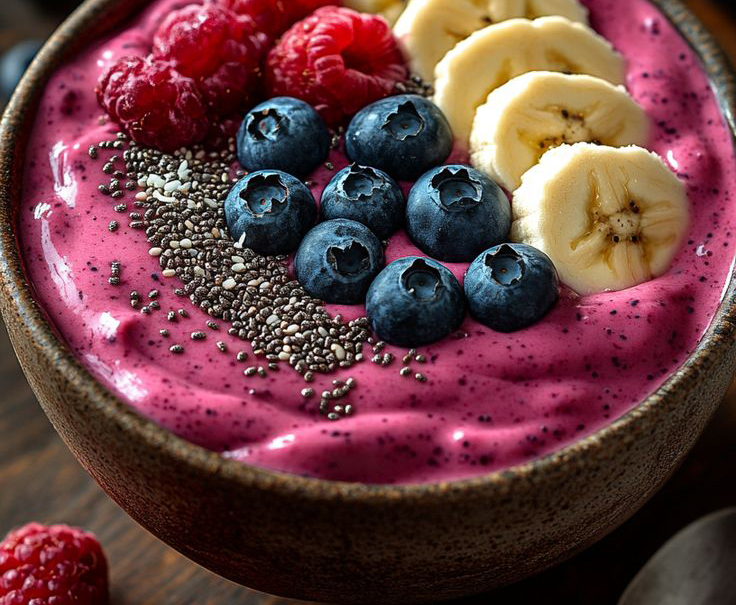
Blend until creamy and smooth.
Polyphenol-rich berries fight oxidative stress; chia and flax offer omega-3s to lower inflammation; Greek yogurt delivers complete protein to stabilize blood sugar and support lean muscle. Fiber slows glucose absorption for sustained morning energy.
Macros & Calories ~350 kcal | 28g protein | 32g carbs | 12g fat
Protein Swap Options: Greek yogurt → plant protein powder, cottage cheese
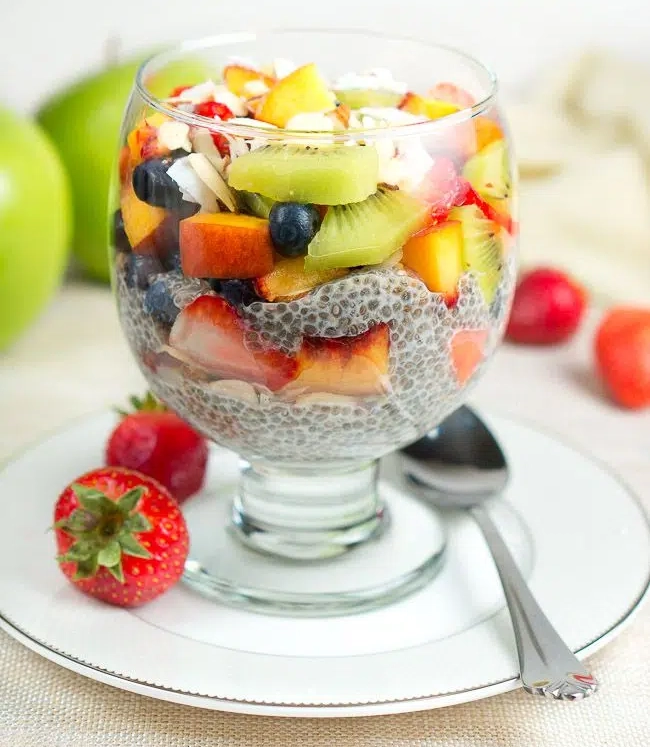
Refrigerate overnight, top with kiwi and hemp seeds.
Chia’s soluble fiber fuels gut health and satiety; hemp adds complete plant protein; collagen promotes youthful skin and strong joints.
Macros & Calories ~300 kcal | 20g protein | 28g carbs | 10g fat
Protein Swap Options: Collagen → whey, hemp protein, or Greek yogurt stirred in

Assemble and serve.
Sprouted grains offer energizing B vitamins, avocado stabilizes blood sugar with healthy fats, and omega-3s in salmon calm inflammation and support brain function.
Macros & Calories ~350 kcal | 25g protein | 28g carbs | 18g fat
Protein Swap Options: Salmon → turkey slices, eggs, or tofu

Layer ingredients; drizzle with tahini dressing.
Balanced plant protein and complex carbs: quinoa builds lean muscle, sweet potatoes offer beta-carotene for glowing skin, and tahini adds calcium for bone strength and hormone balance.
Macros & Calories ~450 kcal | 20g protein | 55g carbs | 18g fat
Protein Swap Options: Chickpeas → grilled chicken, salmon, or tempeh

Cook filling; serve in lettuce leaves.
Protein builds muscle and revs metabolism; cabbage and carrots supply antioxidants and phytonutrients to reduce inflammation and support cellular repair.
Macros & Calories ~350 kcal | 35g protein | 20g carbs | 14g fat
Protein Swap Options: Turkey → chicken, tofu, lentils
Disclaimer
The Content is not intended to be a substitute for professional medical advice, diagnosis, or treatment. Always seek the advice of your physician or other qualified health provider with any questions you may have regarding a medical condition.